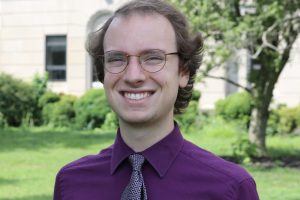
Zachary Pisano PhD ’22 is a new assistant professor in the Department of Applied Mathematics and Statistics. With a background in classical statistics, he studies model selection, extensions of the expectation-maximization algorithm, and random graph inference.
Tell us a little about yourself.
I am a native Pittsburgher who has spent most of my adult life in Baltimore. I obtained my undergraduate degree in statistics at Loyola University Maryland in 2016, shortly before entering Johns Hopkins University as a PhD student in applied mathematics and statistics. I defended my dissertation “Towards an Occam Factor for Random Graphs” in April of 2022, almost two months before joining the department as an assistant research professor.
Describe your research
My work concerns the development of evidence-based model selection criteria for scenarios involving random networks. Should we determine if a particular probability model may have likely generated an observed network, then we can more confidently implement the associated inferential methods, e.g., the clustering of network vertices. For example, we might be interested in whether group structure can be identified within a network. If so, how many groups are there? And moreover, which members (i.e., vertices) of the network belong to which group? These are the sorts of questions such a criterion would reliably answer.
Recent work in this area has appealed to the properties of normal distribution. While useful in practice, such methods, especially for smaller networks, can ignore the actual structure of the data. As a result, methods and inferential tools that better account for how network data are structured would be more appropriate for such settings.
What drew you to this field and focus area?
My background is in classical statistics, with a particular focus on exponential families and the Expectation-Maximization algorithm. My involvement in inference for random graphs has come about through casual conversation with Professor Carey Priebe, who would subsequently (and in an equally casual manner) present me with problems related to my favored topics, albeit with a random graph “twist.” This twist has been sufficient to ensure that the problems on which I work are challenging enough to engage me, yet still yield beautiful and satisfying mathematical results akin to what might be encountered in classical statistics.
Tell us about the real-world applications of your research.
The most obvious application of my research concerns the identification of social networks’ underlying structure. If we are presented with a graph representing a social network, a model selection criterion of the variant I aim to develop would propose the existence of several distinct social groups within that network. Downstream from that task, one can identify the group to which each member of the network is most likely to belong. For example, one can use such methods to determine the similarity or dissimilarity of neurons belonging to different brain regions, or if a sub-community of conspiring malevolent actors exists among a greater community of benevolent citizens.
What excites you about bringing this work to Johns Hopkins?
The people! As a former PhD student in the department, I’m thrilled to finally consider myself a peer and colleague of the many faculty mentors I’ve come to admire during my time here. Quite a few of these faculty (and their students) are hard at work on the same sorts of problems. I am exceedingly grateful that I do not necessarily need to travel far or exclusively communicate electronically to work with my collaborators.
What are some of your goals for this first year at JHU?
My first goal is to submit and publish the sections of my dissertation concerning evidence-based model selection for exponential families, with a light extension to the problem of choosing between the most and least complicated random network models. A fuller exploration and further extension of this problem is currently in progress with one of the department’s PhD students. Outside of research, I hope to refine my teaching abilities as the lead instructor for undergraduate probability and statistics courses.
Anything else we should know? Any fun facts?
One: I play bar trivia—with no small degree of success, if I do say so myself. Two: I play the violin and guitar—both electric. Three: I am an avid movie buff—my all-time favorite is “Fargo.”